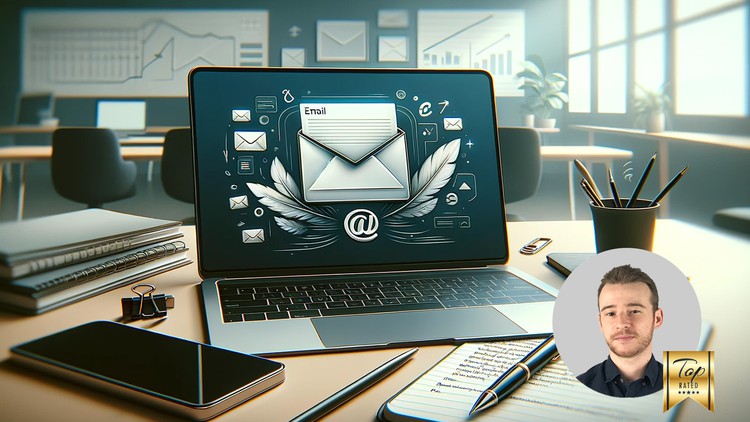Professional Email Writing in English: Complete Training
- Description
- Curriculum
- FAQ
- Reviews
- Grade

Why is it important to master business email communication?
Email writing is an essential skill for any business career. The average office worker sends and receives around 90 emails daily.
If you work for an organization, achieving better professional email communication will make you a strong member of your team and help you get more results.
As a business, if you have 1,000 employees you will send and receive 90,000 emails in a single day. Therefore, making sure all your staff is trained to communicate effectively through email can improve business efficiency and save a huge amount of time and money.
These are just a few examples of things that are communicated daily through email between companies all over the world:
-
Corporate Knowledge
-
Planning and Decision Making
-
Reporting
-
Day-to-day Exchange of Information and Documents
-
Support
-
Scheduling Calls
-
Meetings notes
-
Internal Communication
-
Communicating Rules & Guidelines
-
Announcements
-
Inquiries
-
Personal and Corporate Presentations
-
Sales & Prospecting
In this course, you will learn how to write effective emails on any of the above topics.
How is the course structured to help students learn how to write better professional emails in a short period of time?
Our method is simple, yet highly effective!
First, we lay out all the elements of a professional email:
-
The Recipient Fields
-
The Subject Line
-
The Salutation
-
The Opening Sentences
-
The Body Text
-
The Closing Statements
-
The Professional Signature
-
The Attachments
While we cover each of these elements in detail, we write different types of emails so students really learn how to use them in real-life examples, not just in theory.
Then, we have more in-depth lessons to help students perfect the most important part of the email: the body text.
In this section we cover topics like:
-
Email Formatting
-
Write Short and Concise Sentences and Paragraphs
-
Express Ideas in a Logical Flow
-
Don’t Miss Out on Relevant Information
-
Have the 5 W’s Clear (Who, What, When, Why, Where)
-
Use of Bullet Points and Lists For Better Structuring Information
To finalize this section, we summarize all the above topics in one single guide: The Business Email Best Practices Checklist!
This is an interactive sheet that students can use to easily and quickly apply all the best practices to any new email.
And there is more!
Most courses about professional email writing stop here, but we go further! We provide students with a technical section, where they will learn to:
-
Organize the Email Box for Higher Productivity
-
Setup a Professional Email Signature
-
Activate Out-of-office Responders
-
How to Schedule Conference Calls and Send Calendar Invitations
-
How to Use the Search Tools
* The above topics are shown using Google’s Gmail Client.
About the Instructor
This course is ministered by Ivan Loureço Gomes, a top-rated Udemy instructor, famous for his easy-to-follow and hands-on teaching style. Ivan has more than 15 years of experience working for multinational companies and has sent tens of thousands of emails in his career.
Enroll now and make the best investment of your time and money!
In just a few hours you can master valuable skills that you will use for the rest of your life and will help you succeed in your career! Enroll now and learn how to write effective professional emails today!
This course offers Lifetime Access, a Certificate of Completion and a 30-Day Money Back Guarantee!
-
1Business Email Best Practices
-
2More Best Practices For The Body Text
https://docs.google.com/spreadsheets/d/1GVlmM9l3uLRoY7JM-DYNgvUm5ZZ2kqkwOlnAuV3Y7qE/edit?usp=sharing
-
3The Best Practices Checklist
-
4Download the Checklist
Link for the checklist: https://docs.google.com/spreadsheets/d/1GVlmM9l3uLRoY7JM-DYNgvUm5ZZ2kqkwOlnAuV3Y7qE/edit?usp=sharing
-
5What's Wrong With This Email?
-
6A Real-life Example (Part 1)
-
7A Real-life Example (Part 2)
-
8Two More Emails Needed From You
-
9Grammarly Installation
-
10Email Types: Send and Request Documents
-
11Email Types: Reminders
-
12Send documents and reminders
-
13Email Types: Propose a Conference Call
-
14Email Types: Meeting Notes
-
15Email Types: Company Presentation & Sales Pitch
-
16Email Types: Company Updates - Good News
-
17Email Types: Company Updates - Bad News / Apologies
-
18Send your supplier some bad news












